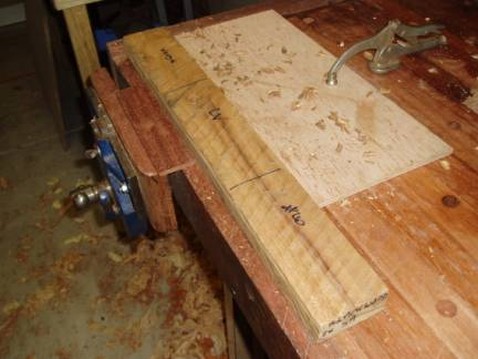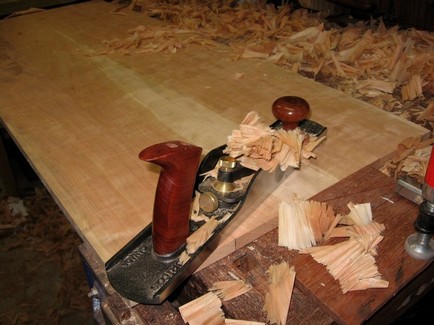When I start working on a rough sawn board, I might want to plane it across the grain (traversing). I might switch to planing on the diagonal. Lately I've been working some curly material with a toothed blade on the diagonal. And then the final finishing strokes are with the grain.
I tend to find that I can secure the work for planing with the grain using a bench dog at one end and the Veritas wonder dog at the other end. This usually works if the board is not too wide and if the ends are not to far off from straight. Failing those conditions, the board can twist free when the plane isn't lined up with the dogs.
The problem of twisting becomes more more serious with planing diagonally, and especially across the grain. If I don't have dog holes in just the right place then I can't secure the ends of the boards and if I plane perpendicular to the grain beyond the dogs the board twists. So then it's necessary to clamp from the front at each end. It seems kind of complicated.
Planing on the diagonal seems creates a similar twisting problem because the planing direction isn't directly towards the supporting dogs.
The twisting problem for perpendicular planing could be solved by screwing a long stop to the bench (longer than the workpiece), but this would prevent me from putting shims under the workpiece to keep it from flexing and moving.
Is there a way of securing the workpiece so that I can plane in any direction, or do I have to use different methods for different planing directions?
What methods do you use for securing the wood for face planing?
I tend to find that I can secure the work for planing with the grain using a bench dog at one end and the Veritas wonder dog at the other end. This usually works if the board is not too wide and if the ends are not to far off from straight. Failing those conditions, the board can twist free when the plane isn't lined up with the dogs.
The problem of twisting becomes more more serious with planing diagonally, and especially across the grain. If I don't have dog holes in just the right place then I can't secure the ends of the boards and if I plane perpendicular to the grain beyond the dogs the board twists. So then it's necessary to clamp from the front at each end. It seems kind of complicated.
Planing on the diagonal seems creates a similar twisting problem because the planing direction isn't directly towards the supporting dogs.
The twisting problem for perpendicular planing could be solved by screwing a long stop to the bench (longer than the workpiece), but this would prevent me from putting shims under the workpiece to keep it from flexing and moving.
Is there a way of securing the workpiece so that I can plane in any direction, or do I have to use different methods for different planing directions?
What methods do you use for securing the wood for face planing?






